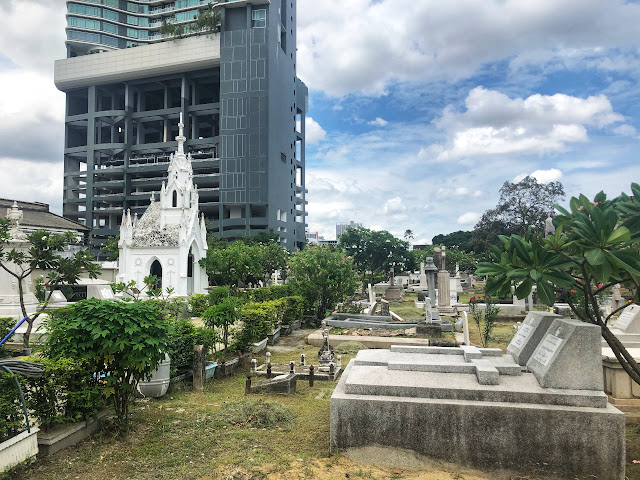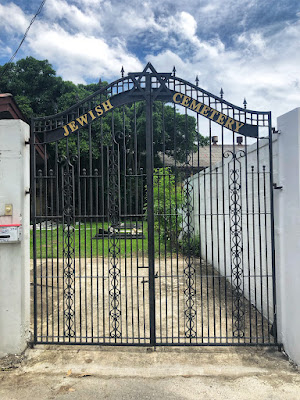The Bangkok Protestant Cemetery and Chapel, Bangkok, Thailand
 |
| Bangkok Protestant Cemetery Chapel |
The Protestant Cemetery and Chapel
Bangkok, Thailand
The Bangkok Protestant Cemetery, located in a beautiful plot of land along the banks of the Chaophraya River in the oldest part of the city, dates back to 1853 when King Mongkut (Rama IV) issued a royal land grant to create a cemetery in order to address the needs of Siam's growing foreign population.
I was in Bangkok's old town the other day, and taking a walk along Charoenkrung Road, the first paved road in Thailand's bustling capital city, when I realized that I was close to the Bangkok Protestant Cemetery. I decided to take a detour to pay it a respectful visit.
 |
| sign at the Bangkok Protestant Cemetery |
The cemetery, which currently has over 1800 graves, is the final resting place for some of Thailand's most notable figures.
 |
| the pathway at the Bangkok Protestant Cemetery |
There's something peaceful about walking through a cemetery, especially one as storied as this one, located along Thailand's "River of Kings". The plot is relatively small; headstones (only 1100 of the 1800 are still readable), mausoleums, graves, and tombs are crammed together in a small yet significant royal grant of land. Though some of the inhabitants may have been lost to history, they are remembered here in their own small way.
 |
| an unknown tomb, Bangkok, Thailand |
Many of the graves date back to the late 19th and early 20th century, although there are still a limited number of gravesites available for purchase.
Perhaps the most prominent tomb at the Bangkok Protestant Cemetery is that of Mr. Henry Alabaster, one of the most significant foreigners in Thailand's modern history.
He returned to Thailand in 1873 after being dismissed by the Foreign Service for "his efforts at keeping Siam from becoming a British colony". He has been historically judged quite positively by Thais for quite the same reason.
Having clearly fallen in love with the country, he rose through the royal ranks to eventually serve as private secretary to King Chulalongkorn (Rama V). During his tenure, Mr. Alabaster oversaw many modernization efforts at this time including the building of roads, bridges and libraries, the founding of the national museum, post office and the royal cartography service, and sending the sons and daughters of royalty and high-ranking positions abroad for study.
Perhaps the most prominent tomb at the Bangkok Protestant Cemetery is that of Mr. Henry Alabaster, one of the most significant foreigners in Thailand's modern history.
 |
| graves and mausoleums at the Bangkok Protestant Cemetery |
Born in Hastings, England in 1836, Mr. Alabaster first came to Siam at the age of 20 in 1856 to serve as an interpreter in the British Foreign Service. As an acting consul, he worked directly with the King of Thailand, and was instrumental in designing the very first paved road in the Thai capital; the very road on which Mr. Alabaster is now interred: Charoenkrung Road.
 |
| the tomb of Mr. Henry Alabaster, Bangkok, Thailand |
He returned to Thailand in 1873 after being dismissed by the Foreign Service for "his efforts at keeping Siam from becoming a British colony". He has been historically judged quite positively by Thais for quite the same reason.
Having clearly fallen in love with the country, he rose through the royal ranks to eventually serve as private secretary to King Chulalongkorn (Rama V). During his tenure, Mr. Alabaster oversaw many modernization efforts at this time including the building of roads, bridges and libraries, the founding of the national museum, post office and the royal cartography service, and sending the sons and daughters of royalty and high-ranking positions abroad for study.
 |
| Mr. Alabaster, one of the most influential foreigners in Siamese history |
The cemetery's chapel is a small, modern Thai-style chapel located in the center of the cemetery. It seats a small number of people and is a quiet and reverent place to hold a memorial. Because of Bangkok's temperamental climate, the chapel is covered in order to protect mourners from the rain that is so common during the monsoon season.
 |
| Bangkok Protestant Cemetery Chapel |
When I visited, the on-site caretakers were using the chapel to store some of their belongings, but I'm sure they would be moved in the case of a funeral or memorial service. While the chapel is covered, it is still open on one side and is not climate controlled.
There are six pews, an altar, and a podium which all stand in front of the congregation. While it is a small place, it's also a very meaningful place.
 |
| interior of the chapel - between services, it stores some of the caretakers' gear |
There are also a number of Jewish graves prominently located in the older part of the cemetery. Because Bangkok has only a very small Jewish community, there was, for a long time, no other appropriate place in the city for a proper Jewish burial.
 |
| Jewish graves in Bangkok, Thailand |
This changed in 1997 with the opening of the small Bangkok Jewish Cemetery on a plot of land adjacent to the Protestant Cemetery.
More beautiful cemetery chapels around the world
Visiting the Bangkok Protestant Cemetery
Visit the cemetery's official website bangkokcemetery.org for more information.Bangkok Protestant Cemetery's burial records and logs are kept by Christ Church, the city's beautiful and historic Anglican church that ministers to Bangkok's small Protestant community.
The Bangkok Protestant Cemetery is located at 2110 Charoen Krung Rd Soi 72/5 Wat Phraya Krai, sub-district, Bang Kho Laem, Bangkok 10120. The cemetery is located on the banks of the Chaophraya River just 1.75 km south of the Saphan Taksin BTS station along Charoenkrung Road. It is very close to the Asiatique night market.
The gates are unlocked and the cemetery is open for visitors to walk around, pay their respects, and sit in contemplation in the beautiful garden overlooking the river every day from 8:00am until 5:00pm. There are always caretakers on the premises.







.JPG)

Comments
Post a Comment